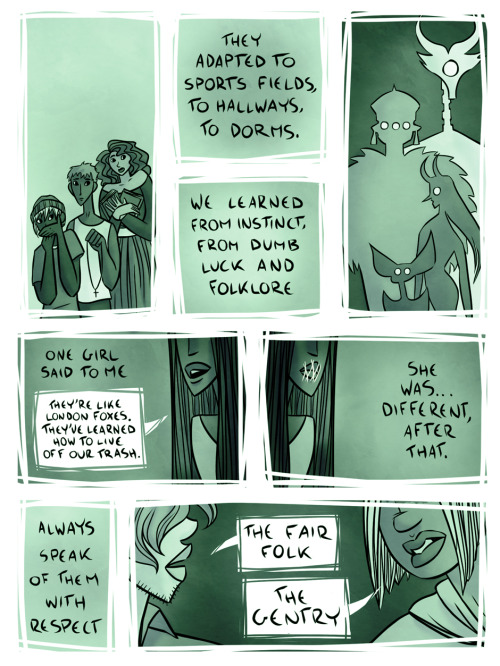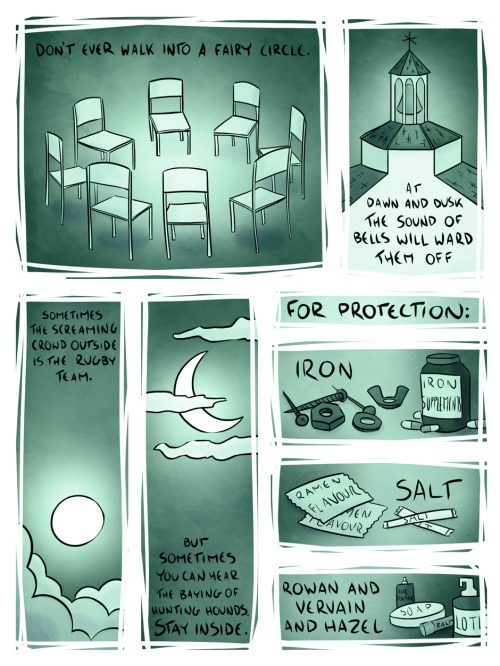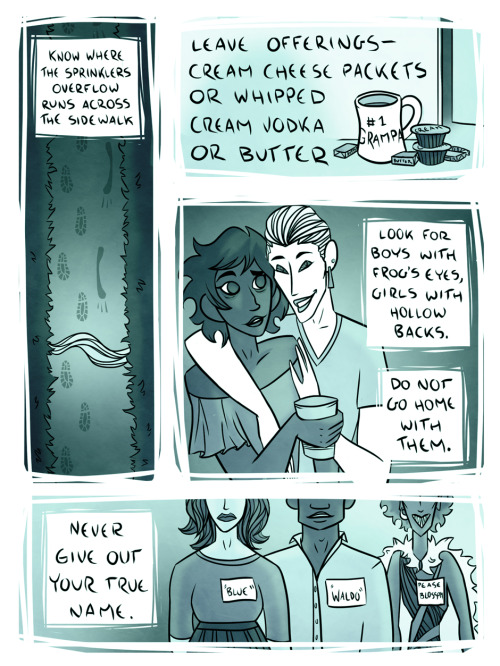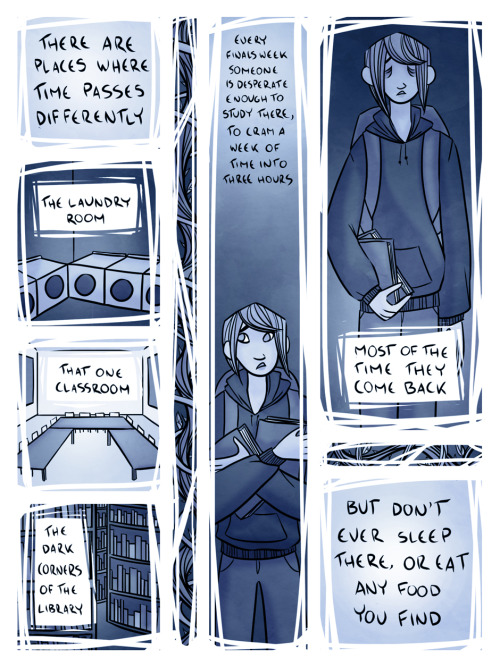Coexisting With The Fair Folk Who Have Taken Up Residence In/Around/Beneath Your University: A How-To








Coexisting With The Fair Folk Who Have Taken Up Residence In/Around/Beneath Your University: A How-To Guide
See more of my comics here, and my art here!
Whole bunch of lore/things I couldn’t fit/everything I love about the overlap in superstition and General College Weirdness below the cut-
Keep reading
More Posts from Foolish-neko and Others
Fairy: Hey I didn’t get your name.
Me: Yeah that was on purpose.
Fairy: Oh my god stealing people’s names has been categorized as a war crime for like a hundred years. Do I seem like the kind of fairy that would do war crimes?
Me: Well yes, but that’s just my impression of you personally. Not fairies in general.
Fairy: You’re smarter than I thought.


Okhmatdyt Children's Hospital in Kyiv, Ukraine after russian missile attack.




Plyontanism (пльонтанізм) is art technique that was invented by Ukrainian artist Ivan Marchuk. The name Plyontanism comes from Ukrainian words 'plesty' (плести) and dialect word 'plyontaty' (пльонтати) that means the same process - to weave.
Incredible Marchuk's technique reminds of woven art or cobwebs. His art is mysterious and thrilling, it makes me feel goosebumps. It's like you see the world with Moira's eyes, who spins the thread of fate.
fun facts about ukrainian vampires (opyr)
• opyri can be of two origins: born and made. made opyri are made by witches, who can smear a baby with blood of a man who went to sleep without praying, thus making the child an opyr.
• opyri have two souls. when opyr dies, only one soul goes to the otherworld. this is why they continue living after death. they aren't immortal though, and only live post-death for seven years. you can presume the person who died was an opyr and will return later if right after their death was a great storm.
• they are very merry fellas and are known to sing, dance and play musical instruments. you can see them partying if you go to the village border at midnight. they also can be spotted smoking a pipe while laying in their coffin.
• opyr can turn into variety of different things: a child, a white or a black dog, a cat, a wolf, a horseman.
• if someone sneezes and you don't respond with "bless you" such person can become an easy target for opyr.
• to get rid of the opyr, you must take them into your arms and carry them across the town or village three times. classical stake to the heart works too.


Crying over this tiny Ukrainian flag amidst ruins after russian strike.
What Ukrainians ate to survive Holodomor
(translated excerpts from an Історична Правда article): + images source
The villagers would dig up the holes of the polecats to find at least a handful of grain hidden by these animals. They pounded it in a mortar, added a handful of oilcake (from hemp seed), beetroot, potato peelings, and baked something from this mixture.
Those who managed to hide at least a little grain would grind it in iron mills made from wheel axles and cook "zatyrukha" (a concoction made from a small amount of flour ground from ears of grain).
Acacia flowers were boiled and eaten raw, and green quinoa was mixed with crushed corn cobs. Those who could - and this was considered lucky - added a handful of bran. This food made their feet swell and their skin crack.

The peasants dried the husked ears of corn and millet husks, pounded them, ground them with weeds, and cooked soups and baked pancakes. Such dishes were impossible to chew, the body could not digest them, so people had stomach aches. Pancakes, the so-called "matorzhenyky", were made from oilcake and nettle or plantain.
It went so far that peasants would crumble straw into small chips and pound it in a mortar together with millet and buckwheat chaff, and tree bark. All this was mixed with potato peelings, which were very poisonous, and this mixture was used to bake "bread", the consumption of which caused severe stomach diseases.
There were cases when village activists took away and broke millstones, mortars, poured water on the heat in their ovens. After all, anything found or saved from the food had to be cooked on fire, and matches could only be purchased by bartering for their own belongings or by buying them in the city, which was impossible from villagers that were on "black lists".

Chestnuts, aspen and birch bark, buds, reed roots, hawthorn and rose hips, which were the most delicious, were used as food substitutes; various berries, even poisonous ones, were picked; grass seeds were ground into flour; "honey" from sugar beets was cooked, and water brewed with cherry branches was drunk. They also ate the kernels of sunflower seeds.
Newborns had the worst of it, because their mothers had no breast milk. According to testimonies, a mother would let her child suck the drink from the top of the poppy head, and the child would fall asleep for three days.
In early spring, the villagers began to dig up old potato fields. They would bake dumplings from frozen potatoes, grind rotten potatoes in a mash and make pancakes, greasing the frying pan with wheel grease. They also baked "blyuvaly" (transl. "vomities") from such potatoes and oatmeal mixed with water, which was so called because they were very smelly.

They ate mice, rats, frogs, hedgehogs, snakes, beetles, ants, worms, i.e. things that weren't a part of food bans and had never been eaten by people before. The horror of the famine is also evidenced by the consumption of spiders, which are forbidden to kill in Ukrainian society for ritual reasons.
In some areas, slugs were boiled into a soup, and the cartilaginous meat was chopped and mixed with leaves. This prevented swelling of the body and contributed to survival. People caught tadpoles, frogs, lizards, turtles, and mollusks. They boiled them, adding a little salt if there was salt. The starving people caught cranes, storks, and herons, which have been protected in Ukraine for centuries, and their nests were never destroyed. According to folk beliefs, eating stork meat was equated with cannibalism.
The consumption of horse meat began in 1931, before the mass famine. People used to take dead horsemeat from the cemeteries at night, make jelly out of it and salt it for future use.

Dead horses were poured with carbolic acid to prevent people from taking their meat, but it hardly stopped anybody. Dead collective farm pigs were also doused with kerosene to prevent people from dismantling them for food, but this did not help either.
After long periods of starvatiom, the process of digestion is very costing for the human body, and many people who would eat anything would drop dead immediately out of exhaustion.
If a family had a cow hidden somewhere in the forest, they had a chance to survive. People living near forests could hunt/seek out berries and mushrooms, but during winter this wouldn't save them. People living near rivers could fish in secret, but it was banned and punishable by imprisonment/death.
don't worry everyone, we are not suicidal (mostly). The River One Song ends with "Я річку шукати чистеньку піду –шукатиму доти, поки не знайду". So, it's very life-affirming!
being ukrainian is a privilege because i get to go ніхто мене не любить ніхто не приласкає піду я у садочок наїмся червячків whenever i'm feeling down
Тамблер чомусь шедов-банить мій книжковий блог та не відображає у загальній стрічці за теґами. Як це з'ясувалося? Бо на нього навіть порно-боти не підписуються! xD
Тамблер, що з тобою не так? Чим тобі відгуки на прочитані книжки не догодили?
-
 walkingaway527 liked this · 1 week ago
walkingaway527 liked this · 1 week ago -
 insertfandomrefhere liked this · 2 weeks ago
insertfandomrefhere liked this · 2 weeks ago -
 never0mind0me liked this · 2 weeks ago
never0mind0me liked this · 2 weeks ago -
 consistentscreaming liked this · 2 weeks ago
consistentscreaming liked this · 2 weeks ago -
 the-excessively-violet liked this · 2 weeks ago
the-excessively-violet liked this · 2 weeks ago -
 humscape reblogged this · 2 weeks ago
humscape reblogged this · 2 weeks ago -
 ashsweet liked this · 2 weeks ago
ashsweet liked this · 2 weeks ago -
 scribblermerlin liked this · 2 weeks ago
scribblermerlin liked this · 2 weeks ago -
 spontaneoustangent reblogged this · 2 weeks ago
spontaneoustangent reblogged this · 2 weeks ago -
 villian-lover7899 reblogged this · 2 weeks ago
villian-lover7899 reblogged this · 2 weeks ago -
 villian-lover7899 liked this · 2 weeks ago
villian-lover7899 liked this · 2 weeks ago -
 superiorjello reblogged this · 2 weeks ago
superiorjello reblogged this · 2 weeks ago -
 randompersonidk reblogged this · 3 weeks ago
randompersonidk reblogged this · 3 weeks ago -
 randompersonidk liked this · 3 weeks ago
randompersonidk liked this · 3 weeks ago -
 that-edgy-gal liked this · 3 weeks ago
that-edgy-gal liked this · 3 weeks ago -
 aurora31127 liked this · 3 weeks ago
aurora31127 liked this · 3 weeks ago -
 arosescrow reblogged this · 3 weeks ago
arosescrow reblogged this · 3 weeks ago -
 therealspaceunicorn liked this · 3 weeks ago
therealspaceunicorn liked this · 3 weeks ago -
 logo-comics reblogged this · 3 weeks ago
logo-comics reblogged this · 3 weeks ago -
 whore-ticulturist reblogged this · 3 weeks ago
whore-ticulturist reblogged this · 3 weeks ago -
 rebloging-things-idk reblogged this · 3 weeks ago
rebloging-things-idk reblogged this · 3 weeks ago -
 tophatturtles liked this · 3 weeks ago
tophatturtles liked this · 3 weeks ago -
 toons-boop-boop reblogged this · 4 weeks ago
toons-boop-boop reblogged this · 4 weeks ago -
 fyrnnicular reblogged this · 4 weeks ago
fyrnnicular reblogged this · 4 weeks ago -
 fyrnnicular liked this · 4 weeks ago
fyrnnicular liked this · 4 weeks ago -
 blackberry-nightingale reblogged this · 4 weeks ago
blackberry-nightingale reblogged this · 4 weeks ago -
 ano-malie reblogged this · 4 weeks ago
ano-malie reblogged this · 4 weeks ago -
 orderdchaosthings2 liked this · 1 month ago
orderdchaosthings2 liked this · 1 month ago -
 crunchyoperator reblogged this · 1 month ago
crunchyoperator reblogged this · 1 month ago -
 blurbofparadise liked this · 1 month ago
blurbofparadise liked this · 1 month ago -
 windoftheuniverse reblogged this · 1 month ago
windoftheuniverse reblogged this · 1 month ago -
 chase-ing-shadows liked this · 1 month ago
chase-ing-shadows liked this · 1 month ago -
 disfordemise reblogged this · 1 month ago
disfordemise reblogged this · 1 month ago -
 disfordemise liked this · 1 month ago
disfordemise liked this · 1 month ago -
 them-faetale reblogged this · 1 month ago
them-faetale reblogged this · 1 month ago -
 them-faetale liked this · 1 month ago
them-faetale liked this · 1 month ago -
 aerspyder reblogged this · 1 month ago
aerspyder reblogged this · 1 month ago -
 aerspyder liked this · 1 month ago
aerspyder liked this · 1 month ago -
 fizzoru liked this · 1 month ago
fizzoru liked this · 1 month ago -
 thearchivething reblogged this · 1 month ago
thearchivething reblogged this · 1 month ago -
 ilikehfjone liked this · 1 month ago
ilikehfjone liked this · 1 month ago -
 gatekeeperrose reblogged this · 1 month ago
gatekeeperrose reblogged this · 1 month ago -
 multi-messhole liked this · 1 month ago
multi-messhole liked this · 1 month ago -
 ruinlas liked this · 1 month ago
ruinlas liked this · 1 month ago -
 innominecarbohydrates reblogged this · 1 month ago
innominecarbohydrates reblogged this · 1 month ago -
 innominecarbohydrates liked this · 1 month ago
innominecarbohydrates liked this · 1 month ago -
 vulcancoded liked this · 1 month ago
vulcancoded liked this · 1 month ago -
 verityshush reblogged this · 1 month ago
verityshush reblogged this · 1 month ago -
 verityshush liked this · 1 month ago
verityshush liked this · 1 month ago -
 word-salad-brain-soup reblogged this · 1 month ago
word-salad-brain-soup reblogged this · 1 month ago



